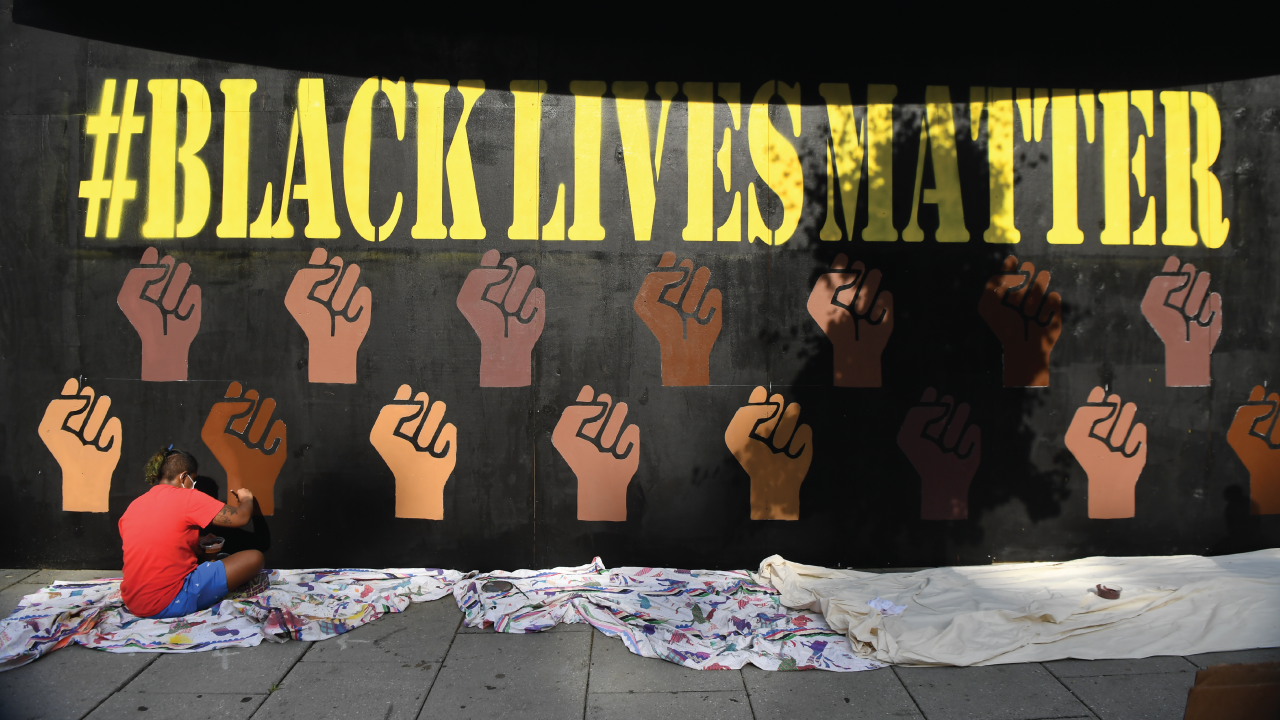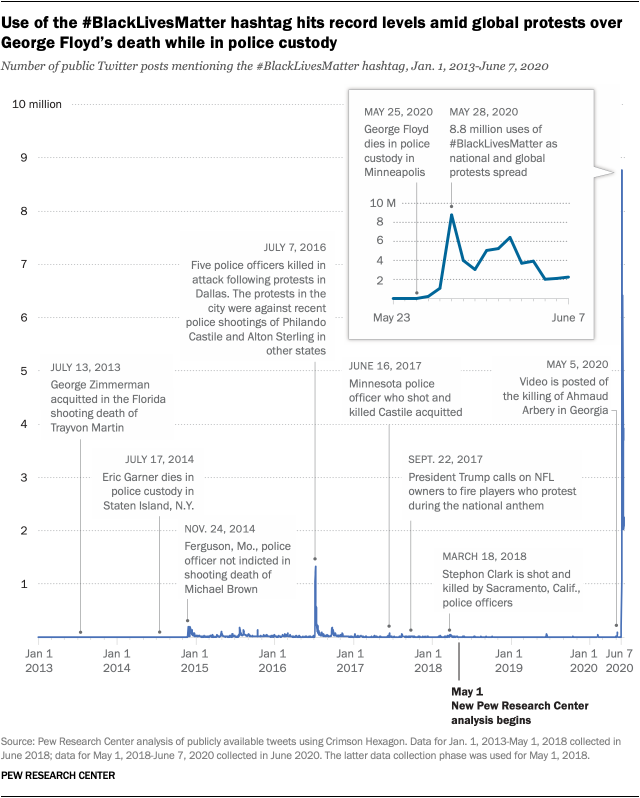
As nationwide protests continue over police brutality and the death of George Floyd, the #BlackLivesMatter hashtag, which is often used in connection with police-related deaths of black Americans, has been used roughly 47.8 million times on Twitter – an average of just under 3.7 million times per day – from May 26 to June 7, according to a new Pew Research Center analysis of publicly available tweets.
Public reactions to the death of Floyd – an unarmed black man – on May 25 while in the custody of Minneapolis police emerged quickly on Twitter. There were roughly 218,000 tweets containing the #BlackLivesMatter hashtag the day after his death, when the first bystander video was posted online. Once protests began in Minneapolis and spread across the country and around the world, daily use of the hashtag passed 1 million on May 27.
On May 28, nearly 8.8 million tweets contained the #BlackLivesMatter hashtag – making this the highest number of uses for this hashtag in a single day since the Center started tracking its use. After that peak, the number of tweets containing the hashtag consistently remained above 2 million uses per day through Sunday, June 7. This is the highest volume of sustained mentions of #BlackLivesMatter in tweets over the time period the Center has studied.
Pew Research Center has tracked the use of the #BlackLivesMatter hashtag as a measure of public reaction to race-related events since 2013, starting with the acquittal of George Zimmerman in the shooting of black teenager Trayvon Martin. Following the death of George Floyd in May 2020, researchers analyzed the use of the #BlackLivesMatter hashtag on Twitter using automated coding software developed by Crimson Hexagon, now part of Brandwatch. This new analysis covers the period of May 1, 2018, through June 7, 2020, and supplements earlier analysis of the hashtag that ran from Jan. 1, 2013, to May 1, 2018. The more recent data collection phase was used for May 1, 2018, in this analysis.
Since these searches were performed at different points in time, there may be methodological or other differences in the software systems used then and now that make them not exactly comparable. However, the volume for use of #BlackLivesMatter in June 2020 is so much greater than the volume observed in prior periods that it is highly unlikely to have resulted solely from methodological or other changes in the methodology and software analytics.
Crimson Hexagon is a software platform that identifies statistical patterns in words used in online texts. This analysis included all public tweets that included the term “blacklivesmatter” during the time range examined. For a more in-depth explanation on how Crimson Hexagon’s technology works, click here. Here is the methodology for this report.
This new analysis also highlights how use of the #BlackLivesMatter hashtag often increases around major news events related to race, violence and criminal justice. For instance, in early May, the hashtag spiked following the release of a video capturing the shooting death of black jogger Ahmaud Arbery by white men in Georgia that occurred in February 2020. There were nearly 86,000 posts containing the #BlackLivesMatter hashtag on May 7, two days after the video emerged.
The phrase “black lives matter” first gained attention after it was used by a black community organizer in a Facebook post following the 2013 acquittal of George Zimmerman in the shooting death of black teenager Trayvon Martin in Florida. Previous Center analyses of the hashtag show that its use and its influence grew to national prominence after Ferguson, Missouri, police officer Darren Wilson fatally shot Michael Brown in 2014 but was not indicted in the death of the black teen in November of that year.
There have been a number of increases in the daily use of the hashtag since Ferguson. One of the most notable spikes occurred over a period of roughly 10 days in in the summer of 2016, when the #BlackLivesMatter hashtag was mentioned an average of nearly 500,000 tweets daily. This time span included news of Alton Sterling being fatally shot by police officers in Baton Rouge, Louisiana, on July 5, 2016. The following day, Philando Castile was shot and killed by a police officer in the suburbs of St. Paul, Minnesota. Then, on July 7, during protests of these deaths, a black gunman killed five police officers in Dallas. Another black shooter killed three officers in Baton Rouge roughly a week and half later.
At the time, these 10 days accounted for the largest numbers of mentions of the #BlackLivesMatter hashtag, according to a 2018 Center report.
Pew Research Center’s previous analysis of the #BlackLivesMatter hashtag covered the period from Jan. 1, 2013, to May 1, 2018, while the most recent analysis studies the period from May 1, 2018, through June 7, 2020. The more recent data collection phase was used for May 1, 2018, in this analysis. Both employed automated coding software developed by Crimson Hexagon, a firm now part of Brandwatch. It is important to note that these searches were performed at different points in time. There may be methodological or other differences in the software used then and now that make these studies not exactly comparable. However, the overall trend is the same and highlights that the #BlackLivesMatter hashtag continues to have periodic increases in daily use, often times in response to news and discussion related to fatal encounters between law enforcement and black Americans.
Note: Here is the methodology for this report.






